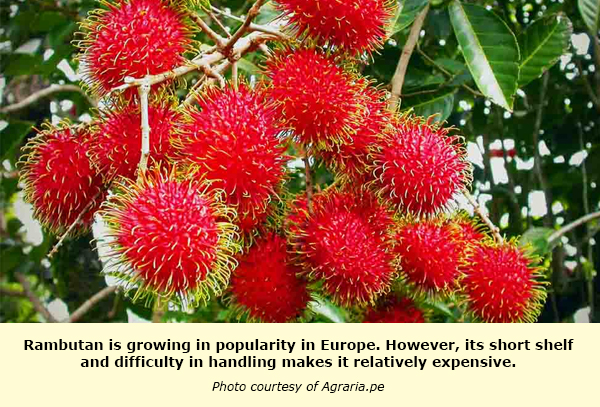Rambutan is starting to gain prominence in Europe’s fruit markets and it has had a great reception among Asian consumers who are on living the continent, as well as in specialty stores.
According to the market intelligence platform of the Center for the Promotion of Imports from Developing Countries, CBI, the European market has imported an estimated average of 500 to 1,500 tons of rambutan in recent years at an approximate value of 4 million euro.

The market for rambutan has the potential to grow due to the increase in interest in this exotic fruit. However, there are limitations to its growth, mainly because it is a difficult fruit to handle and has a short shelf life, which makes it a relatively expensive fruit.
Currently, the largest suppliers of rambutan are Thailand, Malaysia, the Philippines, Indonesia, and Vietnam. They are followed by other providers that supply the fruit in the counter season, such as Ecuador, Honduras, Guatemala, Sri Lanka, Madagascar and a few others from the tropical east of Africa.
In general, rambutan can be found all year round in the European market, but the most important shipments take place between November and March, for the holiday season and the Chinese New Year. Malaysia mainly provides it between December and January, as well as between May and June. The Philippines does it between March and July, as well as between October and November. Meanwhile, Vietnam manages to supply it all year round.
Rambutan cultivation in Peru
According to William Daga, a specialist in fruit trees of Sierra and Selva Exportadora, rambutan was brought to Peru by a private company from the central jungle at the beginning of this century. “The company that brought rambutan has conducted research work with it for six or seven years, with five or six varieties so far, but it has not managed to take off in large or productive areas. They are conducting trials, tuning technology, propagation and adaptation of varieties, but there is still no development and technology,” he said.
For the moment, there is only an average of five to seven hectares of the fruit in Peru, which yield four to five tons a year that are immediately absorbed by Lima’s supermarket sector at very high prices, similar to those of dragon fruit.
Source: Agraria.pe
Translation: Freshplaza
